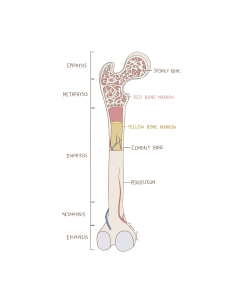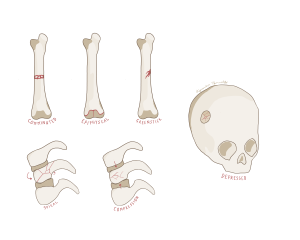33 Introduction to Bones and Fractures
Axial and Appendicular Skeleton:
The human skeletal system is categorized into divisions – either the axial skeleton or the appendicular skeleton. These divisions help organize bones based on their function and location.
Axial Skeleton:
The axial skeleton forms the central core of the body, providing support and protection for the brain, spinal cord, and vital organs within the torso. It consists of 80 bones, including:
- Skull: Consists of the cranial bones (which protect the brain) and facial bones (which form the structure of the face).
- Vertebral Column: Made up of 33 vertebrae, categorized into cervical, thoracic, lumbar, sacral, and coccygeal regions, It provides support and flexibility to the body while protecting the spinal cord.
- Rib Cage: Consists of the sternum and 12 pairs of ribs, protecting the heart and lungs.
Appendicular Skeleton
The appendicular skeleton facilitates movement and includes the bones of the upper and lower limbs, as well as the girdles that attach them to the axial skeleton. It comprises 126 bones, including:
- Pectoral Girdle: Made up of the clavicles (collarbones) and scapulae (shoulder blades), connecting the arms to the thorax.
- Upper Limbs: Consisting of the humerus (upper arm), radius and ulna (forearm), carpals (wrist bones), metacarpals (hand bones), and phalanges (finger bones).
- Pelvic Girdle: Comprising the hip bones (ilium, ischium, and pubis), connecting the lower limbs to the vertebral column (tailbone).
- Lower Limbs: Consisting of the femur (thigh bone), patella (kneecap), tibia and fibula (leg bones), tarsals (ankle bones), metatarsals (foot bones), and phalanges (toe bones).
Anatomy of Bones:
Bones are the structural framework of the human body, providing support, protection, and facilitating movement. They are living tissues that undergo constant remodelling. The anatomy of bones includes several key components:

Figure 72 Anatomy of the bone
Bone Cells:
There are three main types of bone cells involved in various aspects of bone remodelling and formation. Osteoblasts are cells that form bone. Osteocytes are mature bone cells that maintain bone tissue. Finally, osteoclasts are cells that break down bone tissue, primarily aiding in bone remodelling through calcium release.
Composition:
There are two different layers of bone. The first is compact bone, which is the dense, outer layer that provides strength and rigidity. Then, there is spongy bone, the lighter, porous inner structure that supports bone marrow and contributes to the bone’s overall resilience.
Bone Structure:
Life without bones would be like a building without pillars and supports, it would simply topple over. Our body relies on bones to act as our pillars and supports to hold us upright and protect our vital organs.
The universal component of all bones is the periosteum, a dense layer of vascular tissue that connects structures and envelopes the bones, except at the surfaces of the joints. However, long bones have two other major components that you should know about. First, there is the diaphysis, which is the shaft of a long bone, providing leverage and support. Then, there is the epiphysis, which refers to the rounded ends of a long bone, involved in joint articulation and growth.
Bone Marrow:
Bone marrow is a spongy substance found within the center of bones and houses stem cells that produce blood cells like red blood cells – more of this in chapter 7. There are two main types of bone marrow, each serving a different function. Red marrow produces blood cells while yellow marrow stores fat, which can be converted to red marrow if needed.
Bone Shapes:
There are many different types of bones in our human body, and they are designed for different functions.
- Long Bones: Found in the arms and legs, crucial for movement (e.g., femur, humerus).
- Short Bones: Provide support and stability with smaller movement (e.g., carpals, tarsals).
- Flat Bones: Protect internal organs and provide a surface for muscle attachment (e.g., skull, ribs).
- Irregular Bones: Have complex shapes to protect internal organs and provide structure (e.g., vertebrae, pelvis).
- Sesamoid Bones: Embedded within tendons to protect them from stress and wear (e.g., patella).
Fractures:
Given there are numerous types of bones with their own unique properties, they impact how and why they may break. For instance, shattering your ulna in basketball could elicit a completely different fracture from twisting your tibia when stepping in a gopher hole.

Figure 73 Types of fractures
Table 38 Bone fractures, causes and treatments
| Fracture | Description | Common Causes |
| Comminuted | Bone shatters into three or more pieces | High-impact trauma |
| Compression | Bone is crushed, becoming wider or flatter | Osteoporosis or trauma |
| Spiral | At least one part of the bone has been twisted | Twisting injuries, often seen in sports or accidents |
| Epiphyseal | Occurs at the growth plate, common in children | Trauma or stress to the growth plate area |
| Depressed | A piece of the bone is pushed inward | Blow to the head |
| Greenstick | Bone bends and cracks, but does not break completely | Flexible bones |

